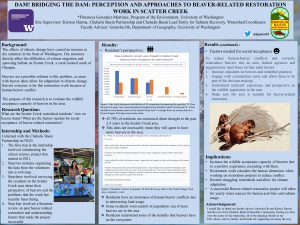DAM! BRIDGING THE DAM: PERCEPTION AND APPROACHES TO BEAVER-RELATED RESTORATION WORK IN SCATTER CREEK
The effects of climate change have caused an increase in dry summers in the State of Washington. This directly affects the difficulties of salmon migration and spawning habitat on Scatter Creek, a creek located south of Olympia and in the Tenino and Rochester areas. The study aims to understand factors that contribute to water flow during the summer in different locations on Scatter Creek. Citizen science and web GIS were used to visualize the patterns of water flow in Scatter Creeks throughout 2021, 2022, and 2023. Daily outreach emails were sent to volunteers to monitor, take pictures, and take notes of the water’s presence and flow. Results show that hotter summer seasons decrease water flows. Areas that had beaver dams within their respective ecosystems had the ability to adapt to the threats of climate change. Allowing for yearly water flow even during hotter summer months. The significance of maintaining water flow regularly throughout the year allows salmon to thrive in their environment through constant waterway paths used for migration routes.
Salmon hold importance to the ecosystem and have cultural significance to the locals and tribes. The Scatter Creek Wildlife Area lies within the traditional range of the Kwaiaik (Q’ʷay’áyiłq’) or Upper Chehalis people (WDFW, 2020). For many years the Upper Chehalis people have survived on the natural resources from the rivers. The locals use the creek for recreational activities and agricultural usage. The creek is a significant source for both non-human and human usage.
